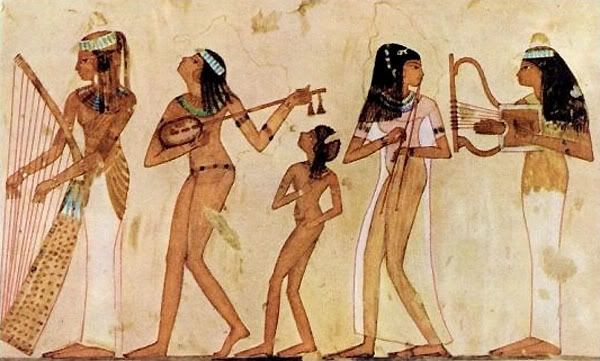 The Egyptian Nefer, a musical instrument from Pharaonic times, is the predecessor to the Oud. It was built and carved from one piece of wood and, like the Oud, is classified as a chordaphone. On ceremonial and religious occasions the nefer (lute) could be accompanied by the harp, lyre and sacred sistrum. Sometimes a small group would accompany the music with hand claps.
The Egyptian Nefer, a musical instrument from Pharaonic times, is the predecessor to the Oud. It was built and carved from one piece of wood and, like the Oud, is classified as a chordaphone. On ceremonial and religious occasions the nefer (lute) could be accompanied by the harp, lyre and sacred sistrum. Sometimes a small group would accompany the music with hand claps.The instrument was adopted by Persian invaders who called it the Barbet. From Persia, it travelled north into Russia and was called the Balalaika, and then East into China and Japan where it was called the Pipa and Biwa respectively. It travelled west to the Arabian Peninsula in the Fifth Century by the Persians and and was called the Oud, which in Arabic means wood (al-ud) and is the root from which the European word "lute" is derived from.
It was the legendary musician Abu-l-Hassan'Ali Ibn Nafi, known as Ziryab (the Blackbird) who is credited for bringing the Oud into Spain during the Moorish period (711-1492 AD). Born in Mesopotamia in 789 AD, he was called "Ziryab" the black bird because of his black complexion, as well as his musical voice and eloquence. (There is also a rare bird of black plummage from that area know as Zaryab, Zeryab or Zariyab. Originally the slave of the famous musician Ibrahim al-Hawsili before moving on to become a musician, Ziryab eventually moved to North Africa where he lived for a number of years.
 It was due to a dispute with his mentor and teacher Ishak, that caused Ziryab to leave North Africa for the Spanish city of Al-Andalus, where after writing an introductory letter to Al Hakam I, the current ruler of Spain, he was invited to Cordova in 822 AD. Ziryab also found favour with and his son and sucessor, Adbur-Rahman II. Ziryab became a very distinguished and wealthy singer in the social circles of Moorish Spain and was well-known outside Moorish Spain's borders. Ziryab founded the first music conservatory in Cordova, invented a plectum made of eagle quill instead of the commonly used wooden ones, and he added a fifth string to the Oud greatly improving its harmony. It was in fact in Moorish Spain that the Oud acquired much of its current characteristics. The Moors constructed many types of Ouds of different tones with varying number of strings.
It was due to a dispute with his mentor and teacher Ishak, that caused Ziryab to leave North Africa for the Spanish city of Al-Andalus, where after writing an introductory letter to Al Hakam I, the current ruler of Spain, he was invited to Cordova in 822 AD. Ziryab also found favour with and his son and sucessor, Adbur-Rahman II. Ziryab became a very distinguished and wealthy singer in the social circles of Moorish Spain and was well-known outside Moorish Spain's borders. Ziryab founded the first music conservatory in Cordova, invented a plectum made of eagle quill instead of the commonly used wooden ones, and he added a fifth string to the Oud greatly improving its harmony. It was in fact in Moorish Spain that the Oud acquired much of its current characteristics. The Moors constructed many types of Ouds of different tones with varying number of strings.The Oud was introduced into Western Europe by the Knights Templar and the Troubadours from Provence who themselves had adopted it from Muslim Spain which was under Moorish rule at the time. This instrument was to play a crucial role in the establishment of the Romantic Courts. Upon its arrival in the British Isles, it was transformed into the western European lute during the Elizabethan period.

No comments:
Post a Comment